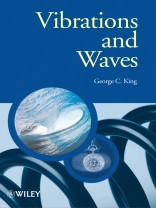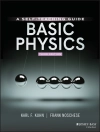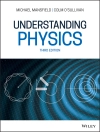This introductory text emphasises physical principles, rather than the mathematics. Each topic begins with a discussion of the physical characteristics of the motion or system. The mathematics is kept as clear as possible, and includes elegant mathematical descriptions where possible. Designed to provide a logical development of the subject, the book is divided into two sections, vibrations followed by waves. A particular feature is the inclusion of many examples, frequently drawn from everyday life, along with more cutting-edge ones. Each chapter includes problems ranging in difficulty from simple to challenging and includes hints for solving problems. Numerous worked examples included throughout the book.
Mục lục
Editors’ Preface to the Manchester Physics Series.
Author’s Preface.
1 SIMPLE HARMONIC MOTION.
1.1 Physical Characteristics of Simple Harmonic Oscillators.
1.2 A Mass on a Spring.
1.2.1 A mass on a horizontal spring.
1.2.2 A mass on a vertical spring.
1.2.3 Displacement, velocity and acceleration in simple harmonic motion.
1.2.4 General solutions for simple harmonic motion and the phase angle phi.
1.2.5 The energy of a simple harmonic oscillator.
1.2.6 The physics of small vibrations.
1.3 The Pendulum.
1.3.1 The simple pendulum.
1.3.2 The energy of a simple pendulum.
1.3.3 The physical pendulum.
1.3.4 Numerical solution of simple harmonic motion³.
1.4 Oscillations in Electrical Circuits: Similarities in Physics.
1.4.1 The LC circuit.
1.4.2 Similarities in physics.
PROBLEMS 1.
2 THE DAMPED HARMONIC OSCILLATOR.
2.1 Physical Characteristics of the Damped Harmonic Oscillator.
2.2 The Equation of Motion for a Damped Harmonic Oscillator.
2.2.1 Light damping.
2.2.2 Heavy damping.
2.2.3 Critical damping.
2.3 Rate of Energy Loss in a Damped Harmonic Oscillator.
2.3.1 The quality factor Q of a damped harmonic oscillator.
2.4 Damped Electrical Oscillations.
PROBLEMS 2.
3 FORCED OSCILLATIONS.
3.1 Physical Characteristics of Forced Harmonic Motion.
3.2 The Equation of Motion of a Forced Harmonic Oscillator.
3.2.1 Undamped forced oscillations.
3.2.2 Forced oscillations with damping.
3.3 Power Absorbed During Forced Oscillations.
3.4 Resonance in Electrical Circuits.
3.5 Transient Phenomena.
3.6 The Complex Representation of Oscillatory Motion.
3.6.1 Complex numbers.
3.6.2 The use of complex numbers to represent physical quantities.
3.6.3 Use of the complex representation for forced oscillations with damping.
PROBLEMS 3.
4 COUPLED OSCILLATORS.
4.1 Physical Characteristics of Coupled Oscillators.
4.2 Normal Modes of Oscillation.
4.3 Superposition of Normal Modes.
4.4 Oscillating Masses Coupled by Springs.
4.5 Forced Oscillations of Coupled Oscillators.
4.6 Transverse Oscillations.
PROBLEMS 4.
5 TRAVELLING WAVES.
5.1 Physical Characteristics of Waves.
5.2 Travelling Waves.
5.2.1 Travelling sinusoidal waves.
5.3 The Wave Equation.
5.4 The Equation of a Vibrating String.
5.5 The Energy in a Wave.
5.6 The Transport of Energy by a Wave.
5.7 Waves at Discontinuities.
5.8 Waves in Two and Three Dimensions.
5.8.1 Waves of circular or spherical symmetry.
PROBLEMS 5.
6 STANDING WAVES.
6.1 Standing Waves on a String.
6.2 Standing Waves as the Superposition of Two Travelling Waves.
6.3 The Energy in a Standing Wave.
6.4 Standing Waves as Normal Modes of a Vibrating String.
6.4.1 The superposition principle.
6.4.2 The superposition of normal modes.
6.4.3 The amplitudes of normal modes and Fourier analysis.
6.4.4 The energy of vibration of a string.
PROBLEMS 6.
7 INTERFERENCE AND DIFFRACTION OF WAVES.
7.1 Interference and Huygen’s Principle.
7.1.1 Young’s double-slit experiment.
7.1.2 Michelson spectral interferometer.
7.2 Diffraction.
7.2.1 Diffraction at a single slit.
7.2.2 Circular apertures and angular resolving power.
7.2.3 Double slits of finite width.
PROBLEMS 7.
8 THE DISPERSION OF WAVES.
8.1 The Superposition of Waves in Non-Dispersive Media.
8.1.1 Beats.
8.1.2 Amplitude modulation of a radio wave.
8.2 The Dispersion of Waves.
8.2.1 Phase and group velocities.
8.3 The Dispersion Relation.
8.4 Wave Packets.
8.4.1 Formation of a wave packet.
PROBLEMS 8.
APPENDIX: SOLUTIONS TO PROBLEMS.
Index.
Giới thiệu về tác giả
Professor George C. King, Department of Physics & Astronomy, University of Manchester, Manchester, UK.












